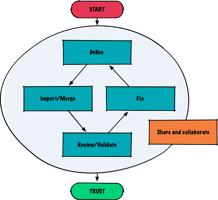Digitalisation strategies have created a fallacy that is often raised - single source of truth -...
The importance of data
Data has emerged as a critical asset for organisations across all industries pursuing a digitalisation strategy. Owners of complex engineered assets, in particular, heavily rely on data to make informed decisions and drive operational improvement. Recent advances in AI, and digital twins have all created opportunities for step change - but in reality success is dependent on the accuracy of the underlying data.
For many organisations the problem isn't finding data, there is plenty of it - the challenge is that many companies struggle to reconcile the large amount of information available to them from the many individual systems and programs within their organisation.
Running multiple systems inevitably leads to duplication of information, discrepancies arise between those systems, and often results in an erosion of trust in the data. This challenge is greater in older assets which have many years of data in a variety of physical and electronic formats created in a range of tools - many of which are now out of date.
The challenge becomes - how to make the most of the data you already have and then how to improve it?
As an owner you are typically faced with two questions about your data
- Do you have the information you need? (Does it exist and if it does can you trust it?)
- Can you find it? (Do you know you need it, where is it and do you have access?)
These questions can be represented in the following diagram.

Every organisation, business unit, and individual asset should be able to use this grid to plot their current position and obviously everyone is seeking to move to the top right quadrant.
Achieving this though can be a big challenge:
- Need to understand the data that exists in your organisation - the data sources.
- Reconciling multiple sources of information is historically a manual process.
- Identifying the "right" information from those sources.
However overcoming these issues and improving the accuracy and consistency of asset data will obviously deliver significant benefits but whose responsibility is it?
The individuals who use the data, and work the asset are often those best placed to understand, correct and improve the data. They are the people who need to trust the data - but to date information tools have been driven by an IT project distanced from the knowledgeable individuals, often focused on graphical based solutions that serve up contextualised inaccuracies.
A better solution is to empower those individuals who rely on the data, maintain the data, to continuously improve, align and complete the data in the range of systems they use daily - without the need for complex integrations, large IT projects, or unmaintainable 3D graphics.
Where an asset owner can better align their data a number of benefits can be achieved
- Enhanced decision making: Accurate and consistent data allows for faster, informed decision making, leading to improved operational efficiency, greater business agility and reduced risk.
- Cost reduction: By eliminating duplication, discrepancies, and errors in data, companies can reduce costs associated with errors, checking and rework.
- Improved trust: When data is accurate and consistent, it builds trust among stakeholders, enabling smoother collaboration, more effective communication and better relationships with regulatory bodies.
- Operational excellence: Having reliable data is the first step for asset owners to optimise their asset performance, to identify areas for improvement, and implement strategies for enhanced operational excellence.
The data you have about your assets is critical to improving performance - delivering lower costs, reduced risks and greater agility.
if you want to know more about how LivingTWIN can help you to get the most from the data you have today then fill out the form below and we will be in touch.


